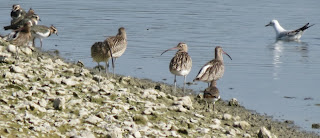TUESDAY 24
SEPTEMBER
Summer seems to have returned with
temperatures this afternoon reaching a balmy 24 degrees C. Light winds
throughout and clear skies but thick fog over part of the area until mid
morning....
At home in the garden, 4 BULLFINCH visited
the Sunflower Heart feeder for about 20 minutes around 0900 hours whilst over at
WILSTONE RESERVOIR (TRING), a full inventory went like this........
Highlight was a party of 4 EURASIAN CURLEW
and single BLACK-TAILED GODWIT that arrived noisily from the east at 1209, not
that long after the fog had cleared. After a few flyarounds, they eventually
came down on the Drayton bank and were still present after I had walked round to
the hide from the jetty. I was able to take a large number of images (see
immediately below) before they finally flew off strongly SSW at 1316. Bill
Pegram, JT and Ken Simmons all connected.
Great Crested Grebe (15 - including the 2
juveniles)
Little Egret (10)
Grey Heron (3)
Mute Swan (45)
Greylag Geese (78)
Mallard (260)
Common Teal (535 - large
increase)
Eurasian Wigeon (135 -
increase)
Gadwall (29)
NORTHERN PINTAIL (4 present - 3 drakes and a
female - my first of the autumn)
Northern Pochard (146)
Tufted Duck (not counted)
Red-crested Pochard (2, with both juveniles
still surviving on Tringford too)
Red Kite (5)
Common Buzzard (6)
HOBBY (at least 3 still
present)
WATER RAILS (8 along SE shore and another by
the hide)
Coot (down to 501 birds)
BLACK-TAILED GODWIT (still 4 juveniles
present whilst an additional bird arrived with the Curlew)
COMMON GREENSHANK (long-stayer still present
in Cemetery Corner)
Common Kingfisher (2)
Great Spotted Woodpecker (1)
Meadow Pipit (slight passage - 4
birds)
Grey Wagtail (4)
Mistle Thrush (2)
LESSER WHITETHROAT (3 - 2 in the East
Hedgerow and another in the orchard)
Blackcap (male in the orchard)
Long-tailed Tit (roving flock of 16 in wood
behind hide)
Chaffinch (light passage - 5 birds
noted)
Bullfinch (pair in the orchard)
WEEDONHILL WOODS, NEAR HYDE HEATH
(BUCKS)
Just in the nick of time, HOBBY was added to
my Recording Area Yearlist, with a family party of 4 birds hunting over the wood
(Don Stone had 5); also Sparrowhawk, 11 Common Buzzard, 15 Red Kite and 28 Stock
Doves, with 6 Barn Swallows through.
































